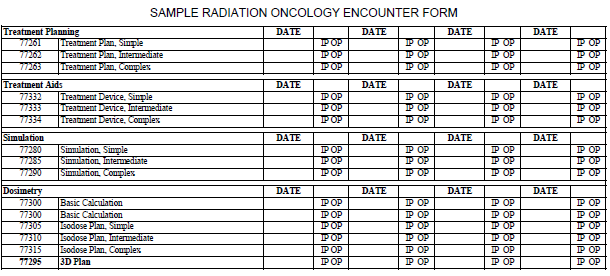The radiation oncology encounter form grew to be a ubiquitous aspect of billing and collections. The forms were used to document services rendered by capturing the diagnosis and procedure codes, which served as the basis for billing and receipt of payment for services. There were a lot of reasons the forms existed for so long. Notably, they:
- Facilitated data entry during the visit
- Could make note taking faster and easier
- Standardized data collection
- Could reduce or avoid documentation costs

However, these forms have become more of a risk than an asset. The biggest problem is that most of these forms are not designed to capture the documentation required to establish medical necessity and cannot be utilized to substantiate a service occurred. Most forms are merely a communication tool to the radiation oncology billing service designating the services for which the provider intends to bill. This raises an important distinction between coding and billing. The only way to code a service is from the actual record of the service, but it’s possible to bill from an encounter form if the provider has already recorded the codes. In the later case, “coders” aren’t really coders. They’re merely entering charges into the practice management system.
The radiation oncology process of care is a series of complex steps that can be separated into five categories that approximate the associated CPT codes. Codes that fall under the general heading of Medical Physics, Dosimetry, Treatment Devices and Special Services have been included within the various stages of the process of care listed below:
- Patient Evaluation
- Preparing for Treatment
- Radiation Treatment Delivery
- Radiation Treatment Management
- Follow Up Care Management
An auditor will always start with the patient record for documentation on each of these stages, and the encounter form will likely not contain the information necessary. If your practice is still using encounter forms, call us. There may be alternatives that we can suggest to improve your documentation and your radiation oncology revenue cycle.


